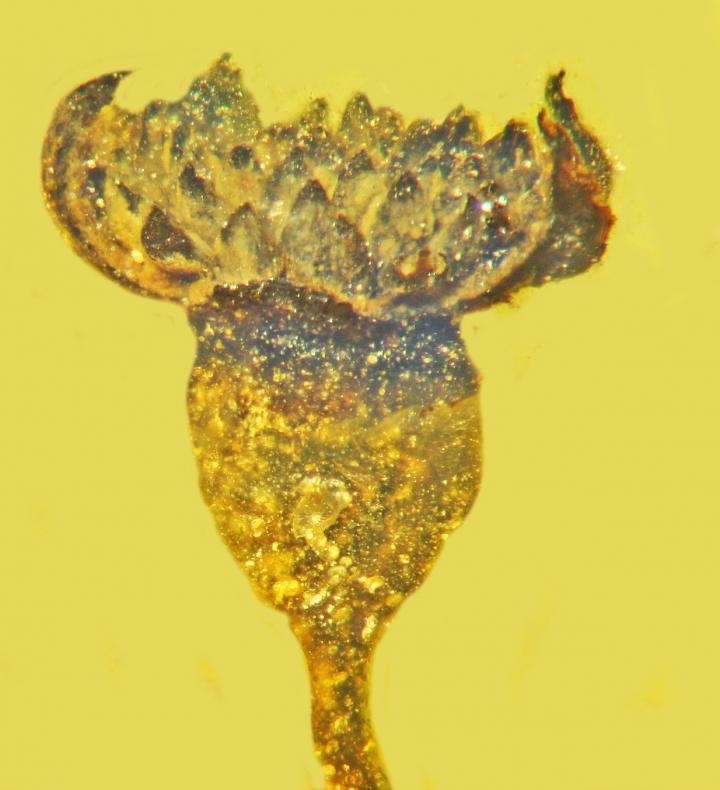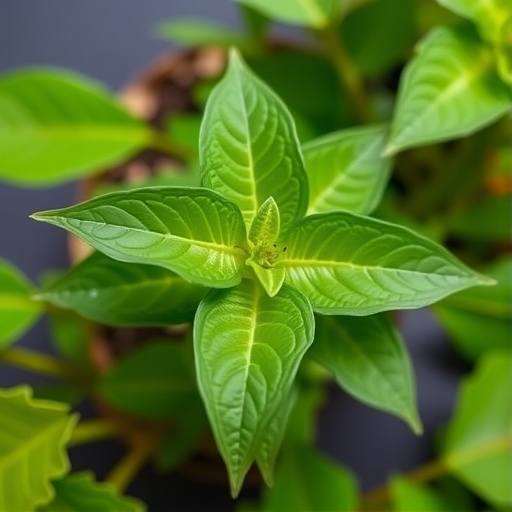
Credit: George Poinar Jr., OSU
CORVALLIS, Ore. – Oregon State University researchers have identified a spectacular new genus and species of flower from the mid-Cretaceous period, a male specimen whose sunburst-like reach for the heavens was frozen in time by Burmese amber.
“This isn’t quite a Christmas flower but it is a beauty, especially considering it was part of a forest that existed 100 million years ago,” said George Poinar Jr., professor emeritus in the OSU College of Science.
Findings were published in the Journal of the Botanical Research Institute of Texas.
“The male flower is tiny, about 2 millimeters across, but it has some 50 stamens arranged like a spiral, with anthers pointing toward the sky,” said Poinar, an international expert in using plant and animal life forms preserved in amber to learn more about the biology and ecology of the distant past.
A stamen consists of an anther – the pollen-producing head – and a filament, the stalk that connects the anther to the flower.
“Despite being so small, the detail still remaining is amazing,” Poinar said. “Our specimen was probably part of a cluster on the plant that contained many similar flowers, some possibly female.”
The new discovery has an egg-shaped, hollow floral cup – the part of the flower from which the stamens emanate; an outer layer consisting of six petal-like components known as tepals; and two-chamber anthers, with pollen sacs that split open via laterally hinged valves.
Poinar and collaborators at OSU and the U.S. Department of Agriculture named the new flower Valviloculus pleristaminis. Valva is the Latin term for the leaf on a folding door, loculus means compartment, plerus refers to many, and staminis reflects the flower’s dozens of male sex organs.
The flower became encased in amber on the ancient supercontinent of Gondwana and rafted on a continental plate some 4,000 miles across the ocean from Australia to Southeast Asia, Poinar said.
Geologists have been debating just when this chunk of land – known as the West Burma Block – broke away from Gondwana. Some believe it was 200 million years ago; others claim it was more like 500 million years ago.
Numerous angiosperm flowers have been discovered in Burmese amber, the majority of which have been described by Poinar and a colleague at Oregon State, Kenton Chambers, who also collaborated on this research.
Angiosperms are vascular plants with stems, roots and leaves, with eggs that are fertilized and develop inside the flower.
Since angiosperms only evolved and diversified about 100 million years ago, the West Burma Block could not have broken off from Gondwana before then, Poinar said, which is much later than dates that have been suggested by geologists.
Joining Poinar and Chambers, a botany and plant pathology researcher in the OSU College of Agricultural Sciences, on the paper were Oregon State’s Urszula Iwaniec and the USDA’s Fernando Vega. Iwaniec is a researcher in the Skeletal Biology Laboratory in the College of Public Health and Human Sciences and Vega works in the Sustainable Perennial Crops Laboratory in Beltsville, Maryland.
###
Media Contact
George Poinar Jr.
[email protected]
Original Source
https:/
Related Journal Article
http://dx.




